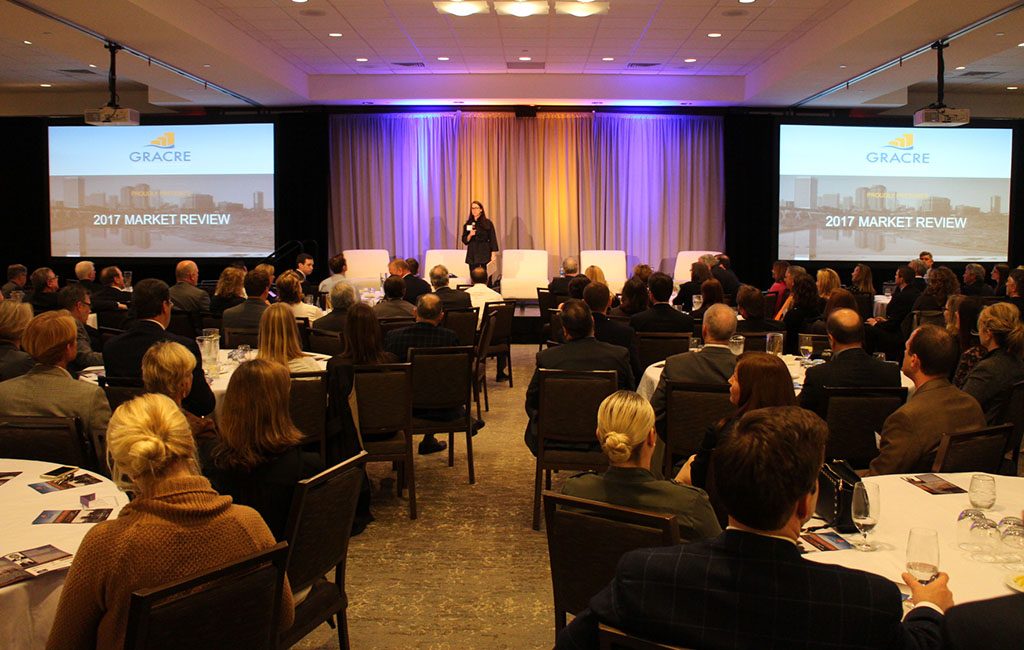
More than 300 commercial brokers gather to hear panelists at the Greater Richmond Association Commercial Real Estate’s 2017 Market report. (J. Elias O’Neal)
To local industry observers, metro Richmond’s commercial real estate market appears to have traveled back in time.
Demand for apartments, burgeoning retail growth, more need for speculative industrial space and a tighter Class A office market are keeping the area’s commercial interests strong, much like it did a decade ago, according to panelists at the Greater Richmond Association for Commercial Real Estate 2017 Market Review event, held Tuesday at the Westin hotel in Reynolds Crossing.
However, appearances can be deceiving, said panelist Andrew Little, principal of John B. Levy & Co.
“I bet if you asked everyone in this room how they did (last year), they would tell you that 2016 was a fantastic year,” Little said. “But if you look at sale volume, we were actually down.”
Little, who discuss capital markets on the panel, said regional brokers completed about $1.4 billion in total transactions in 2016, versus $1.9 billion in 2015.
“It’s skewed,” Little said. “There were a lot of big sales in 2015 … but if you go back and look at 2007, there were about $1.5 billion in trades, so (2016) compares favorably to (2007).”
Little said 2017 does not appear to be headed toward the woes of the Great Recession, which began icing development and market trading around 2008, when lending tightened and private investment plummeted regionally and nationally.
Charles Wentworth, a broker with CBRE | Richmond, echoed Little’s sentiments in regard to the area’s multifamily market.
Wentworth said brokers completed about $350 million in multifamily transactions in 2016. He said that number is expected to climb in 2017, especially in the city, where areas such as downtown, Manchester and Scott’s Addition stand to gain more apartment units as developers and investors chase after millennials.
Wentworth said there are 2,500 apartment units under construction in the region, with an additional 7,500 units in the works.
“We’ve had a pretty consistent uptick in investment sales,” Wentworth said. “There is a lot of money chasing deals across the country.”
Given the area’s continued job growth, its proximity to Washington, D.C. and its affordability compared to markets like Atlanta, Charlotte and Raleigh, Wentworth said investors, mainly out-of-state, are diving into the region to find deals.
“Richmond is on people’s mind,” Wentworth said. “Five years ago, very few people knew what our market was, much less where Virginia was. Now, you go to these conferences and people are asking about Virginia. They see Richmond as an opportunity to get some yield.”
Chris Wallace, a broker with Colliers International, said the city’s improved reputation and affordability are added bonuses for the area’s office market.
“We gave several tours of the James Center when we were going through that disposition process,” Wallace said, referring to the downtown office complex’s recent change in ownership. “We gave about 20 tours from groups all over the country. A lot of these people have never been to Richmond before.”
Wallace said 2016 was a big year for the area’s office market, with CoStar’s lease of 130,000 square feet on the top three floors of the WestRock building, and Owens & Minor set to bring 500 jobs downtown after executing a lease in Riverfront Plaza. Virginia Premier Health Plan Inc. also has signed a lease to take over 135,000 square feet in the Liberty Plaza II building in Innsbrook.
“I feel very good going into 2017,” Wallace said.
Similar optimism was shared for the area’s retail sector. Connie Jordan Nielsen, a broker with Cushman & Wakefield | Thalhimer, said despite a rise in e-commerce sales nationally, demand for brick-and-mortar retail is growing in the metro Richmond market.
She added the area’s appetite for new grocery stores appears to growing.
“There are 170 grocery stores in the Richmond market,” Nielsen said. “I think there are few more holes, which is good news.”
Industrial market panelist Byron Holmes, a broker with Porter Realty Co., said he’s bullish about the 2017 market. He said industrial speculative construction is making a comeback in the region, particularly the area’s growing warehouse and distribution sectors.
Holmes said new spec projects are in the works across the region, as builders begin to move into new areas in Hanover and Chesterfield counties. He said existing industrial employment centers such as Meadowville Technology Park in Chesterfield and White Oak Technology Park in Henrico County help draw more industrial users.
“In many cases a lot of the buildings are already leased up before they are constructed,” Holmes said. “That’s a good sign about the market, and I suspect that trend is going to continue going into 2017.”
Headwinds from global and national influences could affect some progress in the Richmond commercial realty market, panelists said. Looking ahead to 2019, Little said lending could become tighter for new construction as lenders wait to see what previous investments yield.
Then there’s inventory, or the lack thereof, that could slow down deals in 2017, panelists said.
“We just don’t see a lot of product,” Wentworth said of the area’s multifamily market. “Debt’s out there … we just don’t have a lot of product to look at.”
Wallace said Class A office space also is becoming more difficult to find region-wide.
“The largest blocks of space are off the market,” Wallace said, mentioning the James Center as one the few office buildings with contiguous office space available in the central business district. “If a company wants more than 80,000 square feet, there are only a couple of options left.”
Despite a few hiccups in the marketplace that could prolong rapid sales, Little said the region’s commercial real estate sector is performing well.
“There’s a lot of excitement and optimism right now,” Little said. “The city is at an interesting juncture.”

More than 300 commercial brokers gather to hear panelists at the Greater Richmond Association Commercial Real Estate’s 2017 Market report. (J. Elias O’Neal)
To local industry observers, metro Richmond’s commercial real estate market appears to have traveled back in time.
Demand for apartments, burgeoning retail growth, more need for speculative industrial space and a tighter Class A office market are keeping the area’s commercial interests strong, much like it did a decade ago, according to panelists at the Greater Richmond Association for Commercial Real Estate 2017 Market Review event, held Tuesday at the Westin hotel in Reynolds Crossing.
However, appearances can be deceiving, said panelist Andrew Little, principal of John B. Levy & Co.
“I bet if you asked everyone in this room how they did (last year), they would tell you that 2016 was a fantastic year,” Little said. “But if you look at sale volume, we were actually down.”
Little, who discuss capital markets on the panel, said regional brokers completed about $1.4 billion in total transactions in 2016, versus $1.9 billion in 2015.
“It’s skewed,” Little said. “There were a lot of big sales in 2015 … but if you go back and look at 2007, there were about $1.5 billion in trades, so (2016) compares favorably to (2007).”
Little said 2017 does not appear to be headed toward the woes of the Great Recession, which began icing development and market trading around 2008, when lending tightened and private investment plummeted regionally and nationally.
Charles Wentworth, a broker with CBRE | Richmond, echoed Little’s sentiments in regard to the area’s multifamily market.
Wentworth said brokers completed about $350 million in multifamily transactions in 2016. He said that number is expected to climb in 2017, especially in the city, where areas such as downtown, Manchester and Scott’s Addition stand to gain more apartment units as developers and investors chase after millennials.
Wentworth said there are 2,500 apartment units under construction in the region, with an additional 7,500 units in the works.
“We’ve had a pretty consistent uptick in investment sales,” Wentworth said. “There is a lot of money chasing deals across the country.”
Given the area’s continued job growth, its proximity to Washington, D.C. and its affordability compared to markets like Atlanta, Charlotte and Raleigh, Wentworth said investors, mainly out-of-state, are diving into the region to find deals.
“Richmond is on people’s mind,” Wentworth said. “Five years ago, very few people knew what our market was, much less where Virginia was. Now, you go to these conferences and people are asking about Virginia. They see Richmond as an opportunity to get some yield.”
Chris Wallace, a broker with Colliers International, said the city’s improved reputation and affordability are added bonuses for the area’s office market.
“We gave several tours of the James Center when we were going through that disposition process,” Wallace said, referring to the downtown office complex’s recent change in ownership. “We gave about 20 tours from groups all over the country. A lot of these people have never been to Richmond before.”
Wallace said 2016 was a big year for the area’s office market, with CoStar’s lease of 130,000 square feet on the top three floors of the WestRock building, and Owens & Minor set to bring 500 jobs downtown after executing a lease in Riverfront Plaza. Virginia Premier Health Plan Inc. also has signed a lease to take over 135,000 square feet in the Liberty Plaza II building in Innsbrook.
“I feel very good going into 2017,” Wallace said.
Similar optimism was shared for the area’s retail sector. Connie Jordan Nielsen, a broker with Cushman & Wakefield | Thalhimer, said despite a rise in e-commerce sales nationally, demand for brick-and-mortar retail is growing in the metro Richmond market.
She added the area’s appetite for new grocery stores appears to growing.
“There are 170 grocery stores in the Richmond market,” Nielsen said. “I think there are few more holes, which is good news.”
Industrial market panelist Byron Holmes, a broker with Porter Realty Co., said he’s bullish about the 2017 market. He said industrial speculative construction is making a comeback in the region, particularly the area’s growing warehouse and distribution sectors.
Holmes said new spec projects are in the works across the region, as builders begin to move into new areas in Hanover and Chesterfield counties. He said existing industrial employment centers such as Meadowville Technology Park in Chesterfield and White Oak Technology Park in Henrico County help draw more industrial users.
“In many cases a lot of the buildings are already leased up before they are constructed,” Holmes said. “That’s a good sign about the market, and I suspect that trend is going to continue going into 2017.”
Headwinds from global and national influences could affect some progress in the Richmond commercial realty market, panelists said. Looking ahead to 2019, Little said lending could become tighter for new construction as lenders wait to see what previous investments yield.
Then there’s inventory, or the lack thereof, that could slow down deals in 2017, panelists said.
“We just don’t see a lot of product,” Wentworth said of the area’s multifamily market. “Debt’s out there … we just don’t have a lot of product to look at.”
Wallace said Class A office space also is becoming more difficult to find region-wide.
“The largest blocks of space are off the market,” Wallace said, mentioning the James Center as one the few office buildings with contiguous office space available in the central business district. “If a company wants more than 80,000 square feet, there are only a couple of options left.”
Despite a few hiccups in the marketplace that could prolong rapid sales, Little said the region’s commercial real estate sector is performing well.
“There’s a lot of excitement and optimism right now,” Little said. “The city is at an interesting juncture.”



